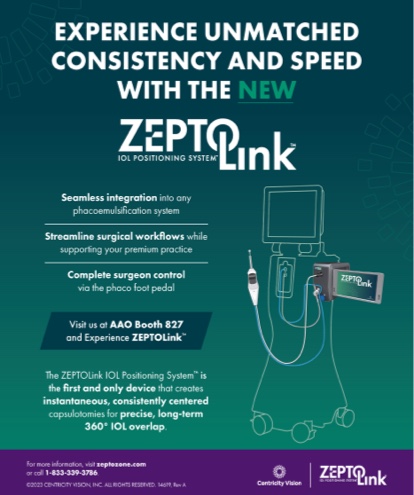

Effects of LipiFlow Treatment Prior to Cataract Surgery: A Prospective, Randomized, Controlled Study
Park J, Yoo YS, Shin K, et al1
Industry support: None
ABSTRACT SUMMARY
The prospective randomized controlled trial included 124 eyes of 124 patients scheduled for cataract surgery and randomly assigned to either the control or treatment group. The latter received treatment with the LipiFlow Thermal Pulsation System (Johnson & Johnson Vision). The effects of the treatment on surgically induced meibomian gland dysfunction (MGD) and dry eye disease (DED) were evaluated. Meibomian gland function and ocular surface parameters were assessed in each group at the baseline visit and at 2 and 3 months after surgery.
Study in Brief
A prospective randomized controlled trial found that preoperative treatment with the LipiFlow Thermal Pulsation System (Johnson & Johnson Vision) significantly improved meibomian gland function and stabilized the tear film after cataract surgery.
WHY IT MATTERS
Ocular surface discomfort is a major cause of dissatisfaction among patients after cataract surgery.
Meibomian gland expressibility, meibum quality, lipid layer thickness, corneal staining, and DED symptoms worsened significantly after surgery in the control group. In contrast, the treatment group experienced an improvement in meibum quality, a reduction in corneal staining, an increase in tear film breakup time (TBUT), and an improvement in subjective outcomes reported on both the Ocular Surface Disease Index (OSDI) and Dry Eye Questionnaire. Patients without baseline MGD who underwent preoperative treatment also showed less worsening of or experienced an improvement in MGD and surgically induced DED after cataract surgery.
DISCUSSION
Patients frequently complain of exacerbated DED symptoms following uncomplicated cataract surgery. Nearly half experience ocular discomfort due to increased ocular surface inflammation, a reduced blink rate resulting from decreased corneal sensation, and the onset of eyelid dysfunction caused by the placement of an eyelid speculum during surgery.2-4 MGD induced by cataract surgery causes postoperative DED and may take 3 to 6 months to resolve.
MGD may lead to patient dissatisfaction after cataract surgery.5 Current treatment modalities include topical antibiotics, steroids, cyclosporine, lifitegrast, systemic tetracycline, nasal sprays, and oral omega-3 supplementation. The cornerstone of MGD treatment, however, is eyelid hygiene, heat application, and eyelid massage. LipiFlow heats the glands to therapeutic levels of at least 40 ºC while applying pulsatile pressure to the outer eyelid surfaces to express the meibomian glands.6
Study patients who received treatment demonstrated an improvement in subjective and objective outcomes at 1 and 3 months after surgery. Interestingly, patients without preoperative MGD who received treatment also experienced an improvement in meibum quality, tear film stability, corneal staining, and DED symptoms.
Based on the study’s results, preoperative LipiFlow treatment may be a safe and effective therapeutic option for relieving MGD and DED induced by cataract surgery. Treatment may be appropriate for patients with and without preoperative MGD.
Evaluation of the Efficacy of Optimal Pulsed Technology Treatment in Patients With Cataract and Meibomian Gland Dysfunction in the Perioperative Period
Ge J, Liu Na, Wang X, et al7
Industry support: None
ABSTRACT SUMMARY
The prospective observational study assessed the safety and efficacy of treatment with the M22 system with Optimized Pulsed Technology (OPT; Lumenis) in patients with age-related cataracts and MGD in the perioperative period. The study included 60 eyes of 60 patients (30 each in the treatment and control groups). The ocular surface parameters evaluated preoperatively and at 1 and 3 months after cataract surgery included corneal staining; TBUT; tear meniscus height (TMH) and OSDI scores; and meibomian glands yielding secretion score (MGYSS); eyelid margin abnormality score (EMAS) for meibomian gland function; and meibography (meibomian gland loss score) for morphology.
Study in Brief
A prospective observational study found that cataract surgery affected meibomian gland function, resulting in dry eye disease. Three sessions of treatment with the M22 system with Optimized Pulsed Technology (Lumenis) before cataract surgery was associated with improved ocular surface health and higher patient satisfaction postoperatively.
WHY IT MATTERS
Safe and effective preoperative strategies for maximizing the health of the meibomian glands after cataract surgery could improve patient satisfaction and quality of life.
In the control group, the OSDI score, TMH, and TBUT were worse 1 month after cataract surgery, and the MGYSS, corneal staining, TMH, and TBUT were impaired 3 months after surgery. In treated patients, the OSDI scores and EMAS improved significantly 1 month after surgery, and the OSDI score, MGYSS, EMAS, and noninvasive TBUT demonstrated improvement 3 months after surgery. Patient satisfaction was greater and the objective parameters of ocular surface health were significantly better in the treatment group.
DISCUSSION
Cataract surgery can exacerbate MGD, which is major source of patient complaints and dissatisfaction postoperatively. After surgery, the OSDI score, MGYSS, TBUT, and corneal staining were impaired in the control group. Meibomian gland morphology and the number of meibomian glands were similar between the two groups. These findings suggest that cataract surgery affects meibomian gland function.
Intense pulsed light therapy was first described in 2015,8 and several studies have since confirmed its efficacy for the treatment of MGD.8-12 OPT treatment improves glandular secretion and excretion by exerting a thermal effect, decreasing the bacterial load and inflammatory response, and reducing cytokine levels and acinar cell edema by blocking dilated capillaries.13
Ge and colleagues demonstrated an improvement in OSDI score, MGYSS, TBUT, meibomian gland function, corneal staining, and EMAS after cataract surgery in patients who underwent OPT treatment preoperatively. The study found that OPT treatment was safe and effective.
1. Park J, Yoo YS, Shin K, et al. Effects of LipiFlow treatment prior to cataract surgery: a prospective, randomized, controlled study. Am J Ophthalmol. 2021;230:264-275.
2. Gupta PK, Drinkwater OJ, VanDusen KW, Brissette AR, Starr CE. Prevalence of ocular surface dysfunction in patients presenting for cataract surgery evaluation. J Cataract Refract Surg. 2018;44(9):1090-1096.
3. El Ameen A, Majzoub S, Vandermeer G, Pisella PJ. Influence of cataract surgery on meibomian gland dysfunction. J Fr Ophtalmol. 2018;41(5):e173-e180.
4. Kim JS, Lee H, Choi S, Kim EK, Seo KY, Kim TI. Assessment of the tear film lipid layer thickness after cataract surgery. Semin Ophthalmol. 2018;33(2):231-236.
5. Li XM, Hu L, Hu J, Wang W. Investigation of dry eye disease and analysis of the pathogenic factors in patients after cataract surgery. Cornea. 2007;26(9 suppl 1):S16-20.
6. Greiner JV. A single LipiFlow Thermal Pulsation System treatment improves meibomian gland function and reduces dry eye symptoms for 9 months. Curr Eye Res. 2012;37(4):272-278.
7. Ge J, Liu Na, Wang X, et al. Evaluation of the efficacy of optimal pulsed technology treatment in patients with cataract and meibomian gland dysfunction in the perioperative period. BMC Ophthalmol. 2020;20(1):111.
8. Craig JP, Chen YH, Turnbull PR. Prospective trial of intense pulsed light for the treatment of meibomian gland dysfunction. Invest Ophthalmol Vis Sci. 2015;56(3):1965-1970.
9. Gupta PK, Vora GK, Matossian C, Kim M, Stinnett S. Outcomes of intense pulsed light therapy for treatment of evaporative dry eye disease. Can J Ophthalmol. 2016;51(4):249-253.
10. Rong B, Tang Y, Tu P, et al. Intense pulsed light applied directly on eyelids combined with meibomian gland expression to treat meibomian gland dysfunction. Photomed Laser Surg. 2018;36(6):326-332.
11. Toyos R, McGill W, Briscoe D. Intense pulsed light treatment for dry eye disease due to meibomian gland dysfunction; a 3-year retrospective study. Photomed Laser Surg. 2015;33(1):41-46.
12. Karaca EE, Evren Kemer Ö, Özek D. Intense regulated pulse light for the meibomian gland dysfunction. Eur J Ophthalmol. 2020;30(2):289-292.
13. Yin Y, Liu N, Gong L, Song N. Changes in the meibomian gland after exposure to intense pulsed light in meibomian gland dysfunction (MGD) patients. Curr Eye Res. 2018;43(3):308-313.




